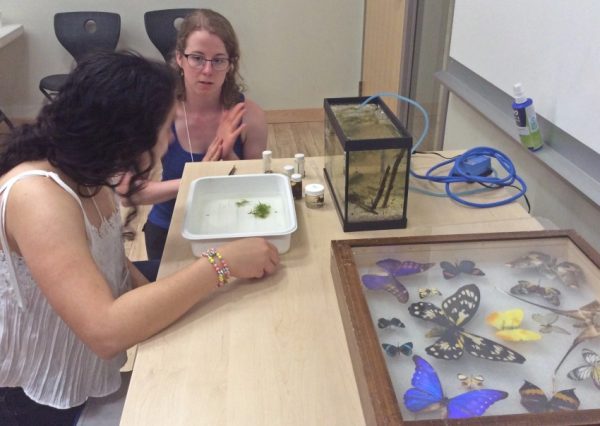February 11 is the International Day of Women and Girls in Science. To celebrate, all February, we’ll be sharing the stories of some of the many women+ at the ABMI who have shaped our organization with their experience, expertise, and dedication. We are inspired by their hard work and the legacy that they are leaving for future scientists. Previous profiles: Fiona Gregory.
Cheryl Tebby, Aquatic Invertebrate Taxonomist
What kind of person is an aquatic invertebrate taxonomist you might ask? To begin, they are a bit of a rare and endangered species, often having to forge their own paths. They of course love aquatic creatures, but they are also likely to be curious, driven, and willing to triple check their work. They can identify hundreds of species and pick a dragonfly nymph out of a line-up. They’ve probably saved the lives of countless bugs from ignorant bystanders and they might not mind being wet and cold on occasion. If you ask them what they love about their work, they might enthusiastically say “looking at bugs, all day, every day!”
And if you are Cheryl Tebby (one of the ABMI’s resident aquatic invertebrate experts), all of these things are true. Fueled by a healthy obsession for chironomids (an incredibly diverse group of non-biting midges), Cheryl is on a mission to develop a key to identify the larvae of this under-appreciated group in Alberta and inspire others to join her in the study of aquatic invertebrates.
Paving the Way
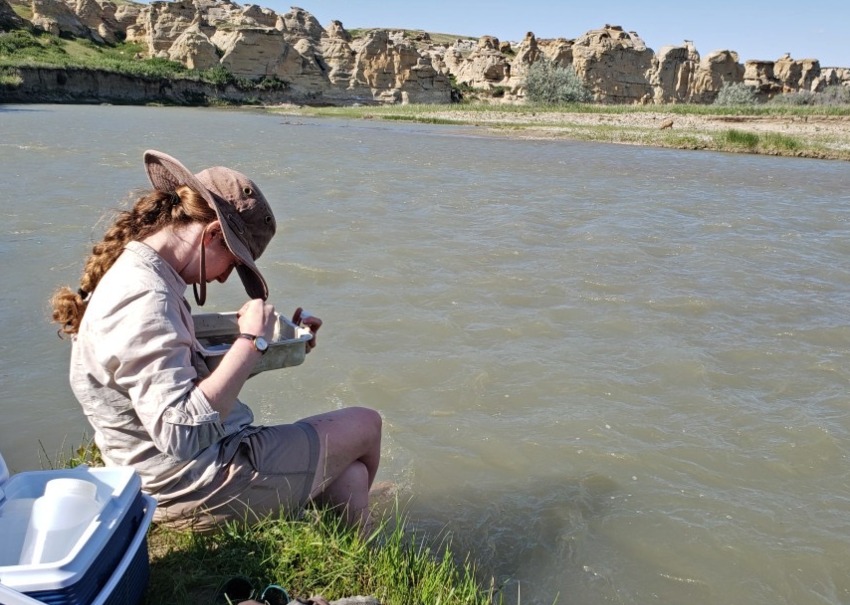
Cheryl Tebby at Milk River, looking for mayflies as part of her casual survey/hunt for a comprehensive list of Alberta’s mayflies.
Cheryl has been an aquatic invertebrate taxonomist at the ABMI for over nine years, and spends much of her time identifying the nymphs, larvae, insects and crustaceans that live in Alberta’s diverse wetlands. Every year, Cheryl and her coworkers identify thousands of aquatic invertebrates that are brought in from the ABMI’s field crews.
Collecting aquatic invertebrates (a group that includes hundreds of species such as caddisflies and water boatmen) allows the ABMI to track population trends across time and ecosystems, giving resource managers a wealth of knowledge about our changing landscapes. “The ABMI is really only one of the few organizations surveying such a wide variety of species, and we are working to create a baseline of data,” says Cheryl.
The aquatic invertebrates team have taxonomic certification through the Society for Freshwater Science and use taxonomic keys and published references describing different features to get the closest and most accurate identification of individual aquatic invertebrates. This also involves checking each other’s IDs, which Cheryl says is one of the best ways to learn.
The identification process usually involves a summer lab extravaganza of field technicians sorting all of the raw samples of plants and invertebrates they’ve collected. The technicians take the material through a washing process to reduce vegetation and sort it systematically. Bottled field samples may initially contain thousands of individuals, but the technicians will get them down to a subsample of around 350. Once that’s done, Cheryl and her team take over and do the fine identifications.
The team publish any discoveries of invertebrates new to Alberta or even new to science, such as with the new Water Boatman records from Alberta and the first recorded co-occurrence of the Valvata snail. This is also part of an effort to provide information on underrepresented species. “Certain groups don’t get a lot of attention, so we’ve kind of had to pave the way for the current science,” says Cheryl.
Chironomids are Cool
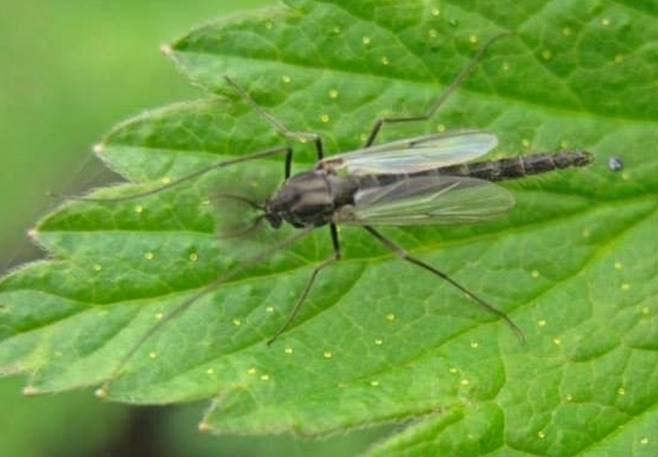
Adult-male chironomid.
One group that doesn’t get much coverage is the underrated chironomid (commonly known as non-biting midges or lake flies). Cheryl’s explorations have led her to make chironomids her taxon of choice and she is working to expand the description of this species group in western Canada and Alberta. This means first documenting the different chironomid morphospecies the ABMI is tracking, and then working towards one day putting species names on them. Eventually, this might also mean Cheryl will be able to work on a province-wide key to help ID all the chironomid species in the area.
“The more you see, the more inspired you feel to take on initiatives to move forward on things, like the chironomid key for instance—I’m sitting on a wealth of knowledge and species descriptions to do.”
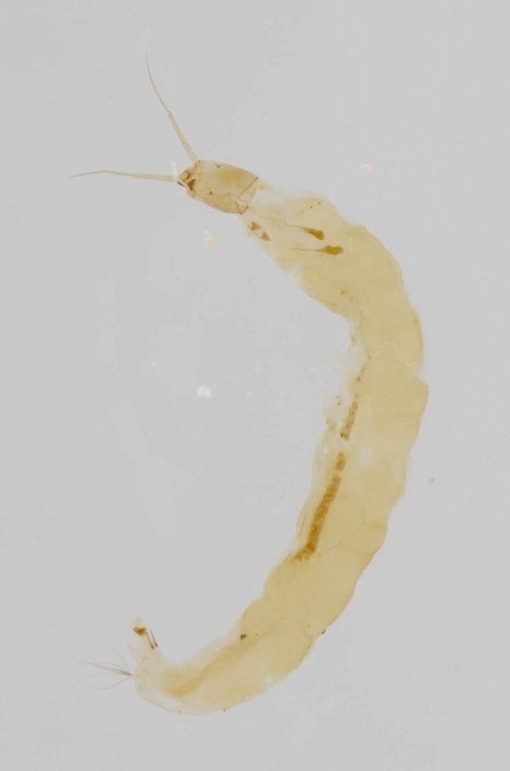
Corynoneura sp.
In addition to providing identifications of aquatic invertebrates in general, creating a key for chironomids is a massive undertaking: there are literally hundreds of species that need to be drawn (illustrated) and examined. This means Cheryl needs to expand her knowledge to include terrestrial invertebrate features such as wing-venation and hair structures of the various adult species–characteristics that are in standard use in classifying more “popular” taxa.
Chironomids are useful indicator species. Since chironomids have species-specific habitat preferences, their presence or absence can give us valuable information. Chironomids also provide a window into the past. In paleolimnology, the study of ancient lake ecosystems, scientists will often find that lake cores contain well-preserved head capsules of chironomids that can be identified, allowing them to infer how the lake has changed.
Focusing on chironomids can be challenging, lonely, and thankless, according Cheryl: “I’ve done presentations on chironomids where I’m trying to share how diverse and cool they are but people don’t usually get it.” Cheryl has searched for other chironomid experts but she says there aren’t many: “I’d like to connect with someone else who is obsessed with them to pool some knowledge,” she says. Despite this, Cheryl has kept her motivation and her passion for chironomids because she knows how rare and important her work is:
“You are just so curious and you want to contribute all that you can because you know that you are one of the few people that has had the years of practice doing this, and I feel like I’m at the point where I want to contribute more but there are only so many hours in a day.”
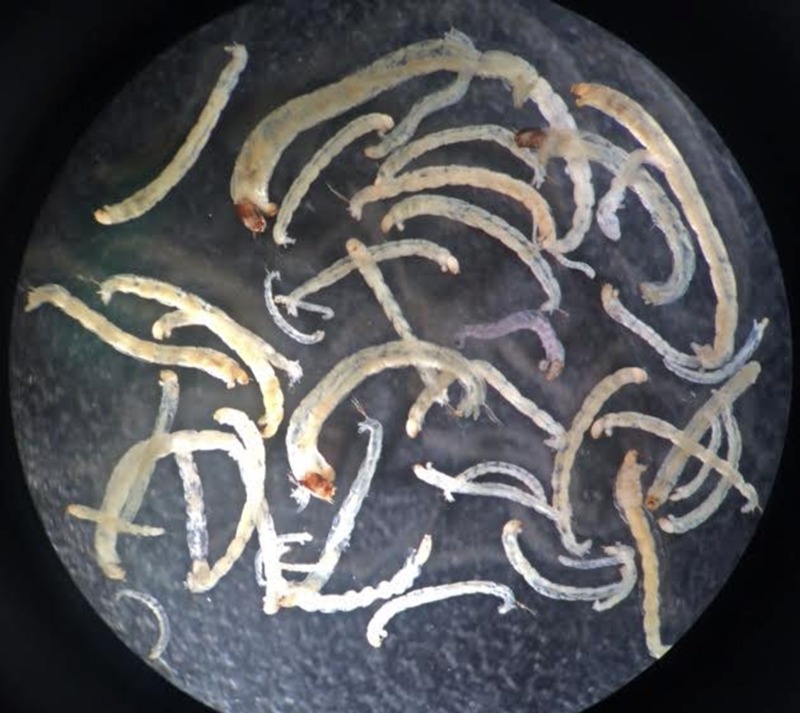
Various chironomid larvae under the microscope.
Pigeon Lake Chironomid Bloom Investigations
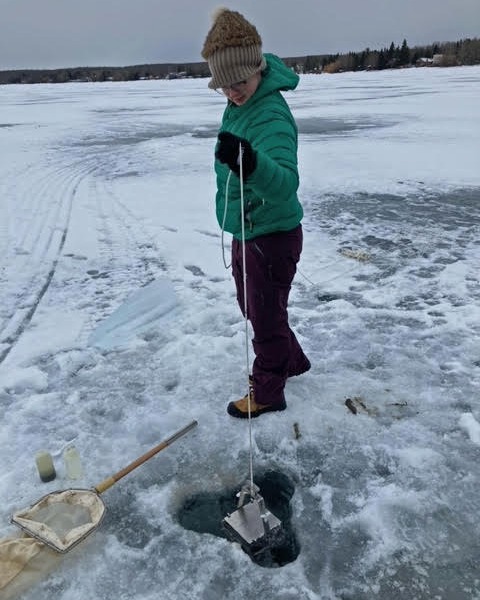
Cheryl doing some winter sampling as part of her work surveying Pigeon Lake’s chironomids. This photo shows her using an Ekman grab to capture some of the chironomids in the sediments.
Cheryl is currently working on a report describing chironomid diversity in Pigeon Lake, where there is particular concern regarding massive chironomid blooms. She is looking specifically at the cause of the blooms and why chironomids are laying eggs on dry land. So she visited the lake in winter and drilled through the ice to collect lake sediment that contains chironomids.
Ponds & Bug Rooms
Cheryl’s fondness for bugs started early. She was the kid who would rescue ladybugs, spiders, or whatever insect got into the classroom, from certain peril. Inspired by her father who was a biologist, Cheryl often explored wetlands searching for frogs and insects. “I do remember coming across some invertebrates then that kind of weirded me out as a kid, but now I know they were Trichoptera and their big protective cases they build out of plant material).” In her native Edmonton, Cheryl would often go to the Bug Room at the Royal Alberta Museum (RAM) where she would hang around hoping a volunteer would let her hold some of the bugs. Years later, the Bug Room would help Cheryl find her way to becoming an aquatic invertebrate expert at the ABMI.
Cheryl started to get serious about bugs and entomology at the University of Alberta, where she graduated with an honours degree specializing in animal biology. Although Cheryl started out studying fish, she felt most at home with the the creatures and the people she met in entomology. In her second year, Cheryl volunteered to work on dissecting tortricids, a tiny brown moth family group found worldwide. A pivotal moment came during her freshwater invertebrate zoology class with Dr. Heather Proctor, who would become a big influence on Cheryl’s career. Throughout the class, Cheryl and her classmates worked on identifying their individual freshwater invertebrate collections to submit at the end of the term. Although it was intense and time-consuming, Cheryl was hooked.
“I remember at one point during the class I thought, “I could do this for the rest of my life.” I was so content and fascinated.”
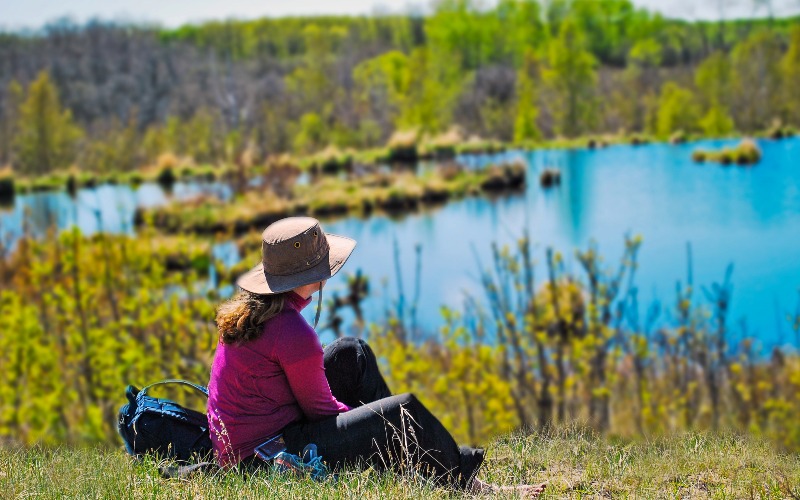
Cheryl Tebby, resting in front of a wetland in south-east Alberta (near Czar).
Cheryl volunteered and later worked in the Bug Room at the Royal Alberta Museum. Due to this experience, her studies, and some good timing, Cheryl eventually joined the ABMI when Rob Hinchliffe was looking for a freshwater invertebrate assistant.
Recently, things came full circle as Cheryl gave a guest lecture in that very freshwater invertebrate course, and even developed a key for the students to follow. “I was pretty pleased because the key worked for what they collected and all of the students actually got their chironomids correct. I was able to give back to the class that started it all and also expand some of the creatures that they could identify…if I could get one more chironomid expert out of that class, that would be my legacy.”
How to Become an Aquatic Invertebrate Taxonomist
Cheryl stresses the importance of volunteering. “Definitely get out there because free labour is always welcome, it’s invaluable for making contacts and it lets you really get a hands-on, closer look at stuff. Even if you end up not liking it, it is an invaluable lesson.”
She says it is important to give the more “boring” taxonomic groups a chance and consider where you feel most welcome and comfortable. “There’s a lot of work that needs to be done on a lot of different insect groups and it’s usually the less flashy ones that are in dire need of someone to pay attention to them.”
Cheryl says things are improving for women in entomology and usually women are equally represented or in abundance at entry level positions. She notes, however, that women are still less frequent at higher graduate and professor levels.
Giving Back
Cheryl spends much of her free time giving back, which she feels is an important aspect of her position. She is part of different naturalist groups focusing on butterflies and amphibians. Cheryl says “I feel like I owe it to all of the frogs I caught and harassed as a kid… and it gets me back in the wetland, which is good.” She also enjoys educating and sharing the love of aquatic bugs with kids as they “go absolutely nuts for the little creatures” at events such as nature nights, bug jamborees, and pond dipping with various groups such as Ellis Bird Farm and Spruce Grove, Parkland County.
“I see it as giving back to the people that ran those events for me as a kid… it’s like all of those people that are there setting the seeds for the future”.
In the future, Cheryl hopes to expand her work to more detailed identification of the many species of chironomids and also inspire others to also become chironomid experts in this fascinating field. For now, she is loving what she is doing:
“It’s like back in that freshwater invertebrate course, it’s the satisfaction of finding what a species is and seeing how it matches up with all of the literature, you feel pretty baller.”
For more Information and Resources:
Cheryl Tebby
- Cheryl Tebby Profile on ResearchGate
- Cheryl Tebby, iNaturalist
- Cheryl Tebby, Alberta Amphibian and Reptile Conservancy
- Cheryl Tebby, Alberta Lepidopterists Guild
Publications
- Nature Alberta Magazine article : “The Alberta Biodiversity Monitoring Institute: A Window into What We’ve Got” by Cheryl Tebby
- Processing Aquatic Invertebrates, Hinchliffe RP, 2015
- New Water Boatman Records from Alberta
- First recorded co-occurrence of Valvata lewisi Currier, 1868 and Valvata lewisi ontariensis Baker, 1931 (Gastropoda: Valvatidae) from Alberta, Canada, with notes on morphometric and genetic variability
Organizations/News
- Society for Freshwater Science
- Bug Gallery at the Royal Alberta Museum
- Biomimicry Alberta
- Bug Guide
- Chironomid emergence at Pigeon Lake: CBC News
Events
- Ellis Bird Farm (annual Bug Jamboree)
- Spruce Grove, Parkland County. (outreach and nature education)

